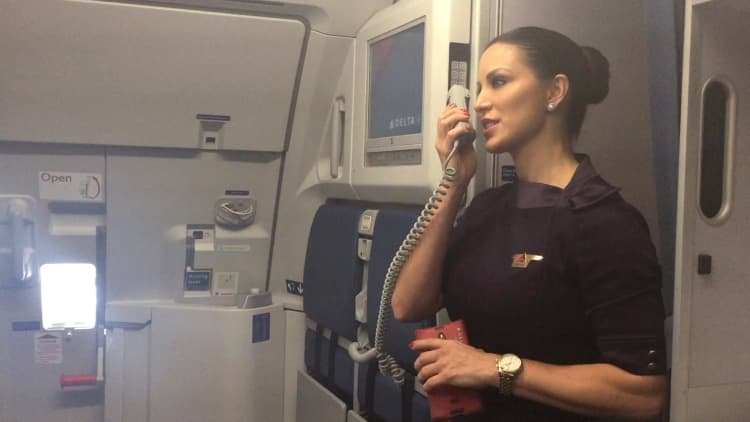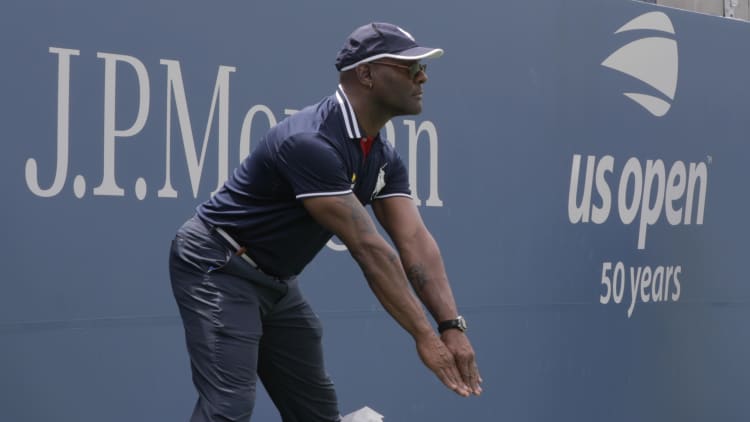Every August, the world's best tennis players compete in front of thousands of fans at the final Grand Slam of the season: the U.S. Open, played in New York City. But the players aren't the only ones feeling the pressure on court: The chair and line umpires have to make split-second line calls, over and over. And often, the ball is traveling upwards of 100 miles per hour.
"We're there when the ball lands that close to the line, in or out, and we have to make the call," says line umpire Kevin Ware, who's working his fourth U.S. Open this year. "It's a very intense concentration job. The stress sometimes can be a little high."
This year, 850 experienced umpires applied to work at the three-week long event, and only 350 got the job.
Like the players, the officials have been training their entire careers to get to the Open. "They start off at the lower level events, move up to ATP and WTA events and then graduate to the U.S. Open and the other Grand Slams," a U.S. Open spokeswoman tells CNBC Make It. "This is the highest level you could be at. By this time, they've had all the training and experience and they are just working to improve."
We headed out to the courts at Flushing Meadows to spend time with Ware and see what it really takes to be a U.S. Open line umpire.
Ware has been officiating full-time ever since he quit his job as a web designer five years ago. "I got tired of my commute and I decided to do the thing I love," he says. "And it worked out, surprisingly." He traveled from his home in San Francisco to get to the Open. That's not unusual: Umpires come from all over the world to work the prestigious tournament. Some officiate full-time and year-round like Ware, while others hold second jobs.
We met up with Ware during the first week of the tournament, when the qualifying matches are played. Here's what his day looked like:
10 a.m.: Arrive at the tennis center
All of the umpires are expected to be on site at 10 a.m. The Open provides shuttle service to and from the hotel in Manhattan where they stay.
They have a locker room where they check in and receive their schedule and court assignment for the day. Ware is the "crew chief," meaning he's in charge of introducing his team members to each other if they haven't yet worked together, passing out the daily schedule and relaying any important information they may need to know before heading out on court.
The standard crew size is seven line umpires, including the crew chief. The only courts with a bigger crew are the stadium courts, which have nine line umpires.
Ware's crew is scheduled for Court 17 on this particular day, but his team and court assignment will rotate throughout the tournament. Play starts at 11 a.m., but his team is working the second shift and won't go on court until noon.
11:45 a.m.: Pre-match meeting
Ware's crew meets outside of Court 17 about 15 minutes before their shift. Ware leads a brief meeting before they head out to relieve the first crew, who have been on court since 11 a.m.
Noon: On court
Ware's first shift lasts from 12 noon to 1 p.m. "We always get a little anxious before that first 'out' call of the day," he says. "You just want to get the lungs going, get the voice going. That's why actually sometimes I will jump around before I go on court just to get myself ready."
When you're on court, like the players, you have to have "a short-term memory," he says: "You can't think about the last calls you made or the last calls you didn't make that you wish you would have made. You have to go on court each time thinking, 'OK, let's see this ball right now.'"
And while they do have to have good eyesight — they have vision checks every other year — one of the biggest misconceptions about that job is that "we all have superman visual powers," says Ware. Instead, he has experience. Thanks to years of training, "I can tell when the ball's touching the line or when it doesn't touch the line."
1 p.m.: Break
After his hour-long shift, Ware heads back to the locker room with his crew. During periods of downtime, "we rest and we do what we need to do to take care of ourselves so that we can get through all of our matches for the day and make as great of calls at the end of the day as we made at the beginning of the day," he tells CNBC Make It.
Ware eats hummus for lunch. "I like to keep it light," he says. "During the day sometimes when you're going to the court and it's warm, you don't want to eat a lot because it can make you sluggish."
2 p.m.: On court
Ware heads back on court for his second, hour-long shift. The day will continue like this until all of the matches are over.
As an umpire, you never know how long or short your day is going to be. "We will go as long as play goes," says Ware. "So if every match goes three sets, we could be here until 10 o'clock or 11 o'clock. We'll keep shifting with the other crew, hour by hour." Rain delays can lengthen the day even more, adds Ware, "but we've trained for this."
And some days are short, he adds: "I've had long days and I've also been able to go see a [Broadway] show on a given night."
What we do sometimes here is very not normal. It's great to put on some jeans and a tee shirt and catch the subway and just be normal.Kevin WareU.S. Open line umpire
At the end of the day, Ware will head back to his hotel room in the city. "I'll put my feet up and watch Family Guy." While the tournament provides a shuttle back to the hotel, "sometimes I like to catch the subway, just because it's nice to feel normal," says Ware. "What we do sometimes here is very not normal. It's great to put on some jeans and a tee shirt and catch the subway and just be normal."
The Open provides each line umpire with a hotel room, meals and transportation during the tournament. They're also paid a daily rate and the amount varies depending on experience. In 2011, the New York Times reported that the highest-rated U.S. Open officials make $250 per day, the lowest pay rate for any Grand Slam tournament at the time. The Times also reported that a portion of the umpires' travel expenses are covered. A spokesperson for the U.S. Open told CNBC Make It that the Times' report is outdated but declined to provide updated pay information.
We caught Ware at the start of the tournament but he'll be there until the tournament ends on September 9. By the final weekend, "everybody has put in a lot of miles of walking and made a lot of calls, but that's when it matters most and that's what we work for. We work hard to be there when it matters most."
And he wouldn't trade the long days for anything: "I love my job. I have the coolest job. When people ask me what I do and I say I'm a tennis official and I'm a line umpire at the U.S. Open I always get a look. And I love that because how many people can say that? Not many."
Don't miss: I spent 10 hours shadowing a Delta flight attendant—here's what it's like to lead a crew
Like this story? Subscribe to CNBC Make It on YouTube!




